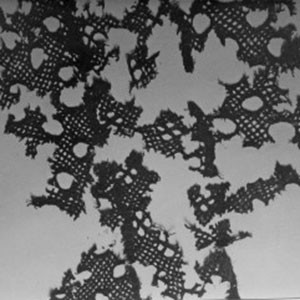Two of the state’s top 10 endangered artifacts, as identified by a subcommittee of the Oklahoma Cultural Heritage Trust, are under the care and preservation of the University of Oklahoma.
The Oklahoma Cultural Heritage Trust’s Top 10 Most Endangered Artifacts program was created to raise awareness and support for proper collections care and preservation for historical items within Oklahoma’s archives, libraries and museums.
Möller Master Organ Player Rolls, circa 1920, housed at the American Organ Institute Archives and Library in the OU School of Music, and Spiro lace, circa 1400 AD, from the historic Spiro Mounds in eastern Oklahoma, housed at the Sam Noble Oklahoma Museum of Natural History, were selected from nominations made by 25 organizations from across the state.
Discovered by an OU excavation team in the late 1930s, the Spiro lace was buried beneath Craig Mound at the historic Native American Spiro Mounds site in eastern Oklahoma, which is known as one of the most significant ceremonial sites in North America. The site was actively used from 800 to 1450 AD.
According to Elsbeth Dowd, museum registrar, archeologists discovered many artifacts beneath the mounds, and the lace survived in part because of its probable proximity to copper plates, whose metallic properties served as a preservation tool.
“This fragment of lace survives as one of Oklahoma’s oldest textiles and offers previously unknown information about the way Native Americans lived centuries ago,” said Dowd.
Dowd believes that much can learned from this small piece of fabric about an ancient artistic and technological tradition of textile production that has been largely lost to history. She hopes that being selected as an endangered artifact will provide the support needed to reassess the conservation needs of this exquisite artifact.
“We are thrilled the Spiro Lace was chosen as one of the Top 10 Most Endangered Artifacts,” said Michael Mares, museum director. “We are working hard to ensure this piece and our entire collection receives proper care so we can continue to share these treasures with visitors for many years to come.”
Also selected as one of the Top 10 Most Endangered Artifacts is a massive collection of paper rolls held by the American Organ Institute. Weighing in at nearly 12 tons, each roll was created by the M.P. Möller Organ Company in the early 20th century as part of an extremely sophisticated and lucrative system that allowed pipe organs to be played automatically via perforated paper rolls, much like player pianos that operated on the same principle. The complete collection includes more than 700 rolls, containing music of every genre.
Often, the rolls recorded live performances by famed musicians of the era. With the advent of high-fidelity recordings, the demand for player organs subsided, and the rolls, as well as the equipment used to create copies, ended up in a barn in northern Michigan for many years. In extremely fragile condition, they must be examined closely by conservators and a plan to stabilize and preserve them must be developed, as well as a method of recording the data they contain so that if their physical condition makes them unusable, they can be recreated.
“When we play these rolls for the public, as we expect to in the near future, we will hear a perfect reproduction of the original performance, given some 90 years ago,” said John Schwandt, director of the American Organ Institute. “The music will be performed as though the long-dead artist was actually sitting at the instrument.”
He added, “This collection is particularly important because there are no audio recordings of organs from the early days of recorded sound, when the technology could not cope with the extreme sonic range and power of the instrument. These rolls tell us how people played and heard music nearly a century ago.”
Organizations from across the state nominated their most endangered works and 25 finalists were selected. In all, more than 177,880 votes were cast. A panel of historians, conservators and experts selected the artifacts by considering each item’s immediate condition and conservation need.
The other top 10 most endangered artifacts selected were the George W. Long Glass Plate and Nitrate Negatives, circa 1910-1940, from the Museum of the Western Prairie; Oklahoma Land Run Registers, circa 1889-1895, from the Oklahoma Department of Libraries and Archives; Pawnee Bill’s Calliope, circa 1910, from the Pawnee Bill Ranch and Museum; Cheyenne War Bonnet, circa 1872, from the Philbrook Museum of Art; Oklahoma State Flag, circa 1925, from the Pioneer Woman Museum; Payne County, Oklahoma Territory Agricultural Census Volumes, circa 1898-1906, from the Stillwater Public Library; Will Rogers’ Polo Suit, circa 1933-1935, from the Will Rogers Memorial Museum; and the U.S. Army Pigeon Basket, circa 1944, from The American Pigeon Museum and Library.
The Oklahoma Cultural Heritage Trust, an alliance between the Oklahoma Department of Libraries, Oklahoma Historical Records Advisory Board, Oklahoma Historical Society, Oklahoma Museums Association and many additional supporting partners, sponsors the Top 10 Endangered Artifacts program. The Oklahoma Cultural Heritage Trust is dedicated to working together with Oklahoma’s collections-based archives, libraries and museums to improve support for collections care through training and public awareness. The Institute of Museum and Library Services, a federal agency, fund activities. For more information about the trust, visit www.culturalheritagetrust.org or call (405) 522-3515.



